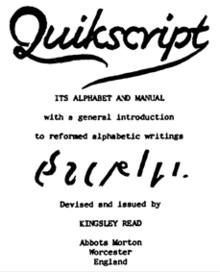Quikscript
Quikscript , also written Quickscript and also known as Read Alphabet and Second Shaw , is a phonetic alphabet for the English language ; the spelling of the English words is strictly based on the actual pronunciation. Quikscript was developed by Ronald Kingsley Read (1887–1975) and probably first published in 1966. It is a revision of the Shaw alphabet , also developed by Kingsley Read. Since Read saw inadequacies in his earlier system, he decided to revise the mother system and recreated most of the characters; Read has completely redesigned at least half of the letterforms in the Shaw alphabet in Quikscript.
In 2013, the entire New Testament was published in Quikscript.
System description
Without the ligatures, Quikscript consists of 25 characters for consonants and 15 characters for vowels . All characters can be inserted in a four-line system . Quikscript has 18 characters made up of only middle lengths (including all vowels). 11 characters consist of middle and ascender length and 11 characters consist of middle and descender length. There is no difference between upper and lower case. Names of persons and places as well as other proper names are indicated by a central point in front if this is necessary for clarity. The punctuation marks correspond to the conventional writing of English texts. Only in the case of the brackets , square brackets are used instead of round brackets due to the risk of confusion with some Quikscript characters, whereby the upper horizontal line is omitted for the front bracket and the lower cross line is omitted for the rear bracket.

The script is divided into the levels Junior Quikscript and Senior Quikscript . Beginners should start learning with the Junior Quikscript basic level . With the exception of the diphthongs , the letters are written side by side without being connected .
In the Senior Quikscript upper level , characters are combined with one another as far as this is graphically possible without changing the character shape . Some letters also have alternative shapes that the scribe can use at will to allow certain letters to be connected. In addition, as in the shorthand systems, there are short characters for the most common words and suffixes . For example, the character for n is used for “and”, the character for f is used for “for” and the character for d is used for the suffix “-ed” in the case of silent e.
Usage today
Quikscript continues to have its followers and is published by them to this day, mostly through the Quikscript website. In 2000 the Read Alphabet group was founded, which under the current name QuikScript group has 505 members (as of December 31, 2019).
See also
literature
- Kingsley Read: Quikscript. Its Alphabet and Manual with a general introduction to reformed alphabetic writings, Abbots Morton / Worcester / England (1966)
- Cole's Funny Picture Book No. 2, 71st (Surprise) Edition, Hawthorn (Australia) 1979, p. 172 - p. 197 - System presentation of the Quikscript under the name Second Shaw
- New Testament in the Read Alphabet (Quikscript), o. O. 2013
- Patricia Smart: Kingsley Read Alphabet Collection. A Catalog, Reading 1983
Web links
- Detailed information and links to Quikscript
- About the history of the Quikscript website of the University of Reading
- Consonant list with memo words
- Vowel overview with memo words
- Test to master the Quikscript characters
- Brief description of Quikscript with text examples
Texts in Quikscript transmission
- The Tower of Babel (Genesis 11: 1-9)
- Henry David Thoreau: On the Duty of Civil Disobedience
- HP Lovecraft: The Call of Cthulhu
References and comments
- ↑ Kingsley Read - photo
- ↑ a b Quickscript. What Kingsley Read did with the Shaw Alphabet
- ↑ For learning purposes, exercise books with the ruling for 1st and 2nd grade can be used.
- ↑ Read, p. 8
- ↑ Read, p. 12
- ↑ Read, p. 18
- ↑ Quikscript website
- ↑ website of the group QuikScript.
- ↑ New Testament - Book Preview

